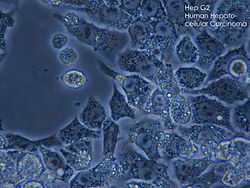Hep G2

Hep G2 is a human liver carcinoma cell line.
Technical reference
ATCC No. HB-8065 Hep G2 (Hepatocellular carcinoma, human)
Hep G2 is a perpetual cell line which was derived from the liver tissue of a 15-year-old Caucasian American male with a well-differentiated hepatocellular carcinoma. These cells are epithelial in morphology, have a modal chromosome number of 55, and are not tumorigenic in nude mice.[1] The cells secrete a variety of major plasma proteins, e.g., albumin, transferrin, and the acute-phase proteins fibrinogen, alpha 2-macroglobulin, alpha 1-antitrypsin, transferrin, and plasminogen.[citation needed] They have been grown successfully in large-scale cultivation systems. Hepatitis B virus surface antigens have not been detected. HepG2 will respond to stimulation with human growth hormone.[citation needed]
HepG2 cells are a suitable in vitro model system for the study of polarized human hepatocytes. (Another well-characterized polarized hepatocyte cell line is the rat hepatoma-derived hybrid cell line WIF-B[2]). With the proper culture conditions, HepG2 cells display robust morphological and functional differentiation with a controllable formation of apical and basolateral cell surface domains (van IJzendoorn et al., 1997; 2000, etc.) that resemble the bile canalicular (BC) and sinusoidal domains, respectively, in vivo.
Because of their high degree of morphological and functional differentiation in vitro, HepG2 cells are a suitable model to study the intracellular trafficking and dynamics of bile canalicular and sinusoidal membrane proteins and lipids in human hepatocytes in vitro.[citation needed] This can be important for the study of human liver diseases that are caused by an incorrect subcellular distribution of cell surface proteins, e.g., hepatocanalicular transport defects such as Dubin-Johnson Syndrome and progressive familial intrahepatic cholestasis (PFIC), and familial hypercholesterolemia.[citation needed] HepG2 cells and their derivatives are also used as a model system for studies of liver metabolism and toxicity of xenobiotics [citation needed], the detection of environmental and dietary cytotoxic and genotoxic (and thus cytoprotective, anti-genotoxic, and cogenotoxic) agents,[3] understanding hepatocarcinogenesis [citation needed], and for drug targeting studies [citation needed]. HepG2 cells are also employed in trials with bio-artificial liver devices [citation needed].
External links
- Literature on polarized HepG2 cells (van IJzendoorn/Hoekstra lab)"
- A three-dimensional cartoon model illustrating HepG2 cell polarity"
References
- ↑ Hep G2, American Type Culture Collection
- ↑ Ihrke, G; Neufeld, EB; Meads, T et al. (1993). "WIF-B cells: an in vitro model for studies of hepatocyte polarity". Journal of Cell Biology 123 (6): 1761–1775. doi:10.1083/jcb.123.6.1761. PMC 2290861. PMID 7506266.
- ↑ Mersch-Sundermann, V.; Knasmüller, S.; Wu, X. J.; Darroudi, F.; Kassie, F. (2004). "Use of a human-derived liver cell line for the detection of cytoprotective, antigenotoxic and cogenotoxic agents". Toxicology 198 (1–3): 329–340. doi:10.1016/j.tox.2004.02.009. PMID 15138059.